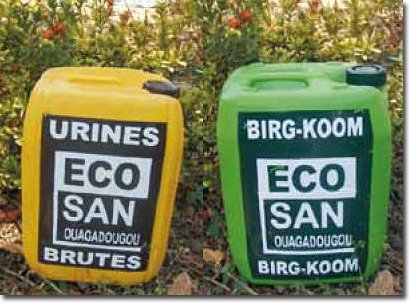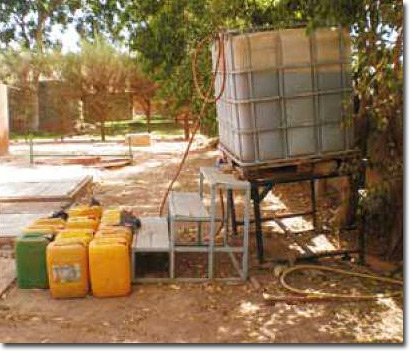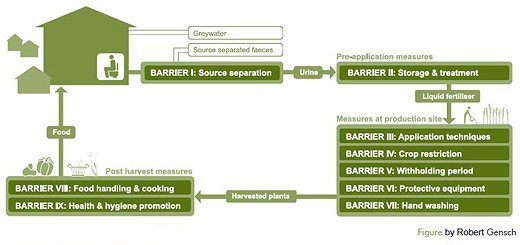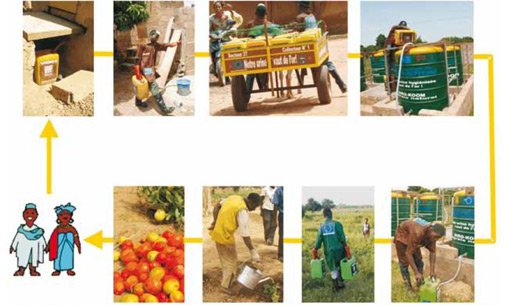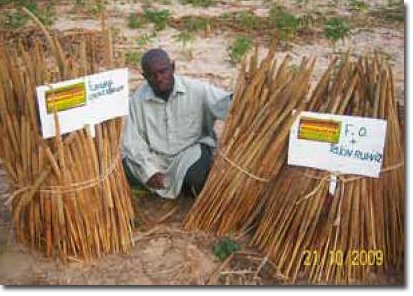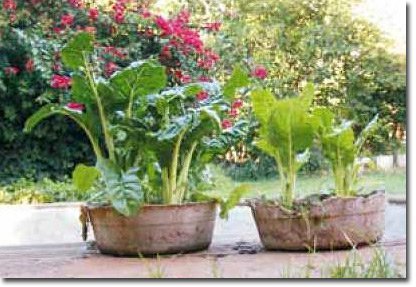How To Use Pee In Your Garden
March 19, 2013 by Erica | Affiliate disclosure
If you can get over the ewwww factor, pee-cycling your own urine into the garden makes good sense. Fresh urine is high in nitrogen, moderate in phosphorus and low in potassium and can act as an excellent high-nitrogen liquid fertilizer or as a compost accelerator.
How To Use Pee In Your Garden
Components of Urine
The exact breakdown of urine varies depending on the diet of the pee-maker. The more protein a person consumes, the more nitrogen will be excreted into the urine. Typical Western Diet pee has an NPK ratio of about 11-1-2. In comparison, blood meal is 12-2-1 and cottonseed meal is 7-2-2.
Urine also contains salt – sometimes quite a lot of it if you are hopped up on a diet of canned soup and french fries. Because of both the salt and high nitrogen levels, urine should generally be diluted 10:1 before use on garden crops. Greater dilution – 20:1 or more – is appropriate for more tender plants, seedlings and potted plants which are more susceptible to salt build up.
Keep in mind that areas with a lot of rain (Seattle!) tend to leach salts out of the soil, so salt build up is something gardeners in arid climates should be more concerned about.
Fresh pee can have a pH anywhere from 5 to 9 depending on a person’s diet, but it tends to move toward neutral as it ages and breaks down when applied outside. I would not personally worry too much about the variable pH of urine for garden use.
Safety Issues
In a healthy person, urine is sterile. In someone with decent hygiene and wiping technique, it should more-or-less stay that way as it leaves the body. Cross contamination with fecal matter (health risk!) can be a concern, so perfect your front-to-back TP technique if you are going to pee-cycle.
If you are on medication, don’t fertilize with your pee. If you have a UTI or other infection or – well, let’s just say anything funky going on in or around your pee-hole – your urine is not fit for garden use.
Grossness Issues
Assuming the safety issues are satisfactorily addressed, then the grossness issue is cultural programing and you should think about if it’s programming you want to keep in your brain. Most gardeners, after all, are pleased as punch to get ahold of a big load of cow poop for their garden, and that fertilizer has a far greater chance of spreading harmful pathogens than pee.
Here’s a few other things to think about:
“Urine accounts for only 1% of the total volume of wastewater, but it contains up to 80% of all the nutrients.”
–Science Daily
A typical toilet flusher wastes “up to 22 liters of drinkable water every day, one three- to six-liter flush at a time. What follows…is the long and costly process of sanitizing the water that was clean before you answered nature’s call. Using so much water per flush unnecessarily increases the volume of our waste and the cost of its transportation and treatment, ecologists say….The process also leaves a huge carbon footprint.”
–Time Magazine
Basically, the environmental and financial cost to piss in a bunch of drinking-quality water and then process it back into drinking water is huge. Separating urine from solid waste – through direct pee-cycling or urine-separating toilets – could go a long way to offset this cost by reducing the burden on wastewater treatment programs.
If the tree-hugger eco stuff doesn’t move you to action, consider the cost of a bag of blood meal. Now consider the cost of your pee. You will never find a more easy-to-acquire, cheaper source of fast acting nitrogen.
Basic courtesy is to not apply urine to those parts of the plant that will be consumed (i.e., as a foliar feed for spinach). Even so, if pee-cycled fertilizer on food crops just grosses you out, consider using this resource on fruit trees, perennials, and ornamental plantings, including your nitrogen-lovin’ lawn, instead.
5 Ways To Use Pee In The Garden
Okay, I’ve convinced you! You are ready to drop trou’ and add your liquid gold deposit to your garden. But how do you pee in the garden in the most effective way (and without getting arrested for indecent exposure in the process!)?
1. Compost Accelerator
Is your compost pile cold? A little long on carbon and low on nitrogen? Pee, poured or – ahem – directly deposited – on the pile can start to speed things up and add moisture. If you are nervous about using urine directly on your plants, incorporating urine into a compost pile is the way to go.
2. Dilution is The Solution
Dilute fresh urine at a 4:1 ratio and apply to the root-zone of corn every two weeks or as needed. (Some people say corn, being a grass, can handle fertilization with straight urine. Proceed with caution.)
Dilute fresh urine at a 10:1 ratio and apply to the root-zone of fruiting plants like tomatoes, peppers and eggplant, or to leafy crops like cabbage, broccoli, spinach and lettuce every two weeks or as needed.
Dilute fresh urine at a 20:1 ratio and water in to the root zone of seedlings and new transplants.
3. The Straw Bale Sprinkle
When Straw Bales are used for gardening, they must be “conditioned” or partially broken down / composted before use. This is accomplished with the addition of a very high nitrogen fertilizer. Guess which free, Bud Lite-hued high-nitrogen fertilizer I’d recommend?
4. Deep Mulch Direct Application
If you thickly mulch your woody perennials, cane fruit and fruit trees with a high-carbon material like leaves or woodchips, you can apply your urine straight onto the mulch, which will absorb and moderate the straight shot of nitrogen in your pee.
5. That Asparagus Smell!
If asparagus makes your pee smell funny, take revenge and pee on your asparagus! Nutrient hungry, deep rooted, perennial and salt-tolerant, asparagus might be the ideal crop to fertilize with pee. If you grow your asparagus under a thick layer of carbonaceous mulch, like straw or wood chips, use the Direct Mulch Direct Application technique, otherwise dilute 2:1 if your asparagus is in the sandy soil it prefers, or 4:1 in heavier soil. Apply throughout the growing season, along with a good source of potassium, like bone meal, in the early spring.
Pee-cycling Sexism
So Adam and Eve are standing in the Garden of Eden right after the Creation and God is handing out the last of the talents, qualities and features he has for each of them. He reaches into his bag and pulls out a slip of paper.
“Ability to Pee Standing Up,” booms God. “Okay, who wants this one?”
“Oh, pick me!” yells Adam, “Pick me! Peeing while standing up sounds like such a very male thing to do, God. I really think that one has to go to me. Sorry Eve, but I really think I need this one.”
God looks at Eve, who just shrugs. “Sure, if it’s that important to him, give Adam the peeing thing. I don’t really care.”
God hands Adam the slip of paper and says, “Forevermore, Adam, by your choice shall men be endowed with the ability to pee whilst standing.”
Adam grins and God reaches to the very bottom of his bag. “Just one more, and I guess since Adam got Peeing While Standing Up, this last one goes to you, eh, Eve? Let’s see…”
God unfolds his final slip of paper. “Okay, here you go Eve: Multiple Orgasms is all yours.”
{ba-dum-bum}
It is a fact of life that men are better equipped to pee all over things. If you are a male gardener, combine your skills and start marking your veg territory with pride. The Deep Mulch Direct Application method will be simplest if you want to water directly from the hose, so to speak.
Ladies, I highly recommend you use Adam’s gift to all men to your advantage, too. Got a husband? Boyfriend? Better yet, a son or two? Give them carte blanche permission to pee on the compost pile. Direct that natural ability (and, dare I say, inclination) for outdoor pee marksmanship towards something good for your garden.
But don’t let the guys have all the fun. You’ll notice that most of the techniques for applying urine as a fertilizer call for dilution anyway, which means a watering can or container is going to be involved. Most women with regular access to lady-specific medical care have had plenty of practice peeing in cups – put that experience to use, for the good of your garden.
Do you already pee on the compost, or does the very idea of pee-cycling leave you pissed!?
http://www.nwedible.com/how-to-use-pee-in-your-garden/


